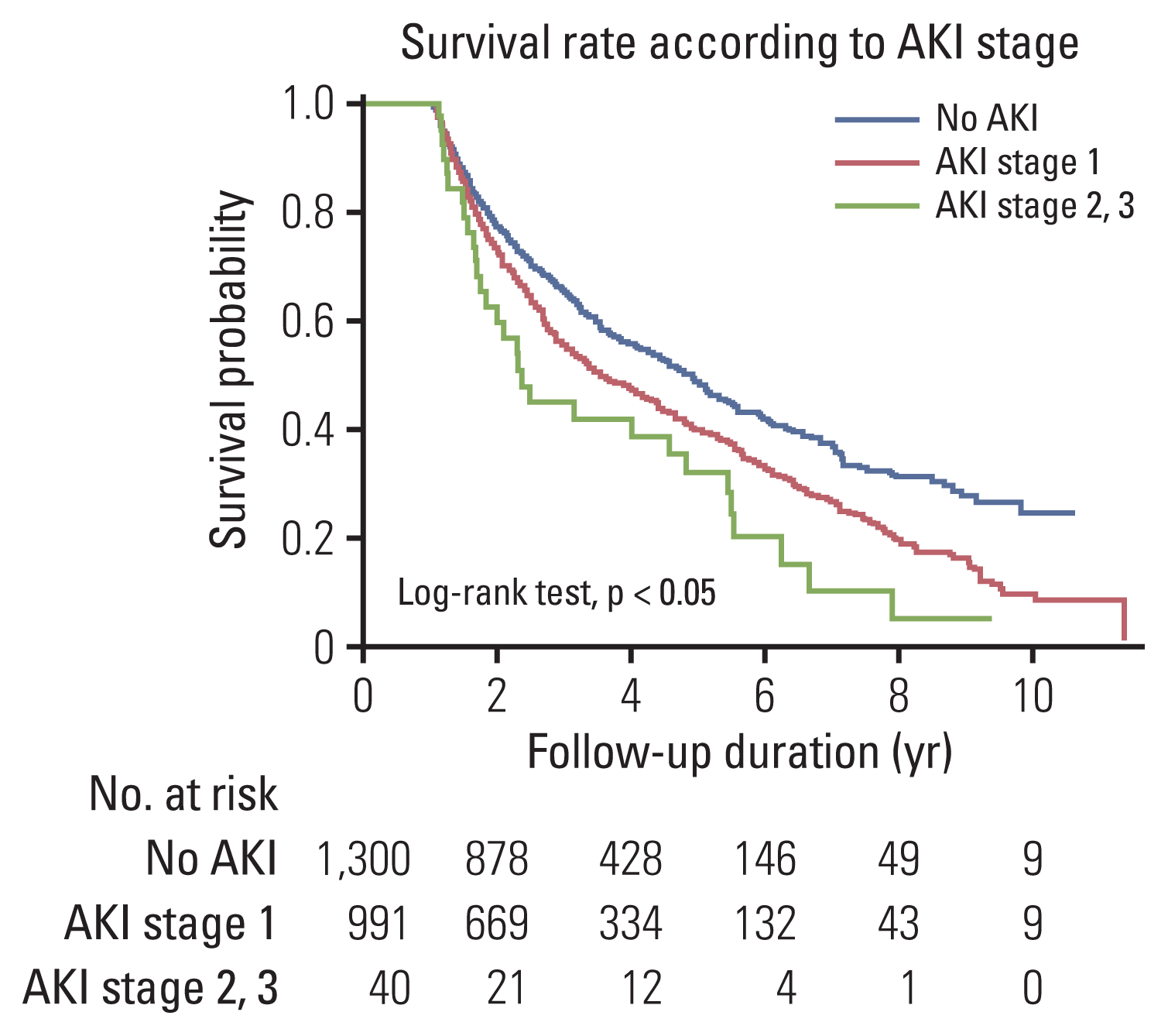1. Berns JS, Rosner MH. Onco-nephrology: what the nephrologist needs to know about cancer and the kidney. Clin J Am Soc Nephrol. 2012; 7:1691.

2. Rosner MH, Perazella MA. Acute kidney injury in patients with cancer. N Engl J Med. 2017; 376:1770–81.

3. Janus N, Launay-Vacher V, Byloos E, Machiels JP, Duck L, Kerger J, et al. Cancer and renal insufficiency results of the BIRMA study. Br J Cancer. 2010; 103:1815–21.

4. Christiansen CF, Johansen MB, Langeberg WJ, Fryzek JP, Sorensen HT. Incidence of acute kidney injury in cancer patients: a Danish population-based cohort study. Eur J Intern Med. 2011; 22:399–406.

5. Lam AQ, Humphreys BD. Onco-nephrology: AKI in the cancer patient. Clin J Am Soc Nephrol. 2012; 7:1692–700.

6. Kogon A, Hingorani S. Acute kidney injury in hematopoietic cell transplantation. Semin Nephrol. 2010; 30:615–26.

7. Rosolem MM, Rabello LS, Lisboa T, Caruso P, Costa RT, Leal JV, et al. Critically ill patients with cancer and sepsis: clinical course and prognostic factors. J Crit Care. 2012; 27:301–7.

8. Canet E, Zafrani L, Lambert J, Thieblemont C, Galicier L, Schnell D, et al. Acute kidney injury in patients with newly diagnosed high-grade hematological malignancies: impact on remission and survival. PLoS One. 2013; 8:e55870.

9. Kitchlu A, McArthur E, Amir E, Booth CM, Sutradhar R, Majeed H, et al. Acute kidney injury in patients receiving systemic treatment for cancer: a population-based cohort study. J Natl Cancer Inst. 2019; 111:727–36.

10. Park SE, Hwang JH, Choi JH, Kim SH, Choi JC, Jang JS, et al. Incidence, risk factors, and clinical outcomes of acute kidney injury caused by palliative chemotherapy in lung cancer. J Cancer. 2019; 10:5332–8.

11. Cardinale D, Cosentino N, Moltrasio M, Sandri MT, Petrella F, Colombo A, et al. Acute kidney injury after lung cancer surgery: Incidence and clinical relevance, predictors, and role of N-terminal pro B-type natriuretic peptide. Lung Cancer. 2018; 123:155–9.
12. Fernandez FG, Kosinski AS, Furnary AP, Onaitis M, Kim S, Habib RH, et al. Differential effects of operative complications on survival after surgery for primary lung cancer. J Thorac Cardiovasc Surg. 2018; 155:1254–64.

13. Park N, Kang E, Park M, Lee H, Kang HG, Yoon HJ, et al. Predicting acute kidney injury in cancer patients using heterogeneous and irregular data. PLoS One. 2018; 13:e0199839.

14. Kang E, Park M, Park PG, Park N, Jung Y, Kang U, et al. Acute kidney injury predicts all-cause mortality in patients with cancer. Cancer Med. 2019; 8:2740–50.

15. Park PG, Hong CR, Kang E, Park M, Lee H, Kang HJ, et al. Acute kidney injury in pediatric cancer patients. J Pediatr. 2019; 208:243–50.

16. Levey AS, Stevens LA, Schmid CH, Zhang YL, Castro AF 3rd, Feldman HI, et al. A new equation to estimate glomerular filtration rate. Ann Intern Med. 2009; 150:604–12.

17. Young JL Jr, Roffers SD, Gloeckler Ries LA, Fritz AG, Hurlbut AA. SEER summary staging manual 2000. Bethesda, MD: National Cancer Institute;2001.
18. Santos ML, de Brito BB, da Silva FA, Botelho A, de Melo FF. Nephrotoxicity in cancer treatment: an overview. World J Clin Oncol. 2020; 11:190–204.

19. Kunitoh H. Top 10 reasons why you must learn onco-nephrology. Jpn J Clin Oncol. 2016; 46:2–3.

20. Ettinger DS, Wood DE, Aisner DL, Akerley W, Bauman JR, Bharat A, et al. NCCN guidelines for non-small cell lung cancer. Plymouth Meeting, PA: National Comprehensive Cancer Network;2020.
21. Kidney Disease: Improving Global Outcomes (KDIGO) Acute Kidney Injury Work Group. KDIGO clinical practice guideline for acute kidney injury. Kidney Int Suppl. 2012; 2:1–138.
22. Samuels J, Ng CS, Nates J, Price K, Finkel K, Salahudeen A, et al. Small increases in serum creatinine are associated with prolonged ICU stay and increased hospital mortality in critically ill patients with cancer. Support Care Cancer. 2011; 19:1527–32.

23. Aygencel G, Turkoglu M, Turkoz Sucak G, Benekli M. Prognostic factors in critically ill cancer patients admitted to the intensive care unit. J Crit Care. 2014; 29:618–26.

24. Bernhardt EB, Jalal SI. Small cell lung cancer. Cancer Treat Res. 2016; 170:301–22.

26. Park S, Lee S, Kim Y, Lee Y, Kang MW, Han K, et al. Risk of cancer in pre-dialysis chronic kidney disease: a nationwide population-based study with a matched control group. Kidney Res Clin Pract. 2019; 38:60–70.

27. Fossa SD, Vassilopoulou-Sellin R, Dahl AA. Long term physical sequelae after adult-onset cancer. J Cancer Surviv. 2008; 2:3–11.

28. Kim M, Kim IH, Lim MK, Kim Y, Park B. Increased prevalence of metabolic syndrome in adult cancer survivors: Asian first report in community setting. Cancer Epidemiol. 2019; 58:130–6.

29. Vigneri P, Frasca F, Sciacca L, Pandini G, Vigneri R. Diabetes and cancer. Endocr Relat Cancer. 2009; 16:1103–23.

30. Rizzoli R, Body JJ, Brandi ML, Cannata-Andia J, Chappard D, El Maghraoui A, et al. Cancer-associated bone disease. Osteoporos Int. 2013; 24:2929–53.

31. Porta C, Cosmai L, Gallieni M, Pedrazzoli P, Malberti F. Renal effects of targeted anticancer therapies. Nat Rev Nephrol. 2015; 11:354–70.

32. Lamb EJ, Tomson CR, Roderick PJ. Clinical Sciences Reviews Committee of the Association for Clinical Biochemistry. Estimating kidney function in adults using formulae. Ann Clin Biochem. 2005; 42(Pt 5):321–45.

33. Ma YC, Zuo L, Chen JH, Luo Q, Yu XQ, Li Y, et al. Improved GFR estimation by combined creatinine and cystatin C measurements. Kidney Int. 2007; 72:1535–42.

34. Darmon M, Ciroldi M, Thiery G, Schlemmer B, Azoulay E. Clinical review: specific aspects of acute renal failure in cancer patients. Crit Care. 2006; 10:211.
35. Shingarev R, Glezerman IG. Kidney complications of immune checkpoint inhibitors: a review. Am J Kidney Dis. 2019; 74:529–37.





 PDF
PDF Citation
Citation Print
Print



 XML Download
XML Download